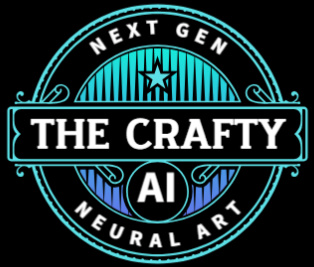www.thecraftyai.com
Styles and Themes in AI Art-Part 4
One of the most exciting parts of working with AI-generated images is exploring the endless range of styles and themes you can create. Whether you're into dreamy fantasy portraits, retro posters, surreal abstracts, or photo-realistic scenes, AI can do it all.
In this part 4, we’ll dive into the most popular styles and creative themes used in AI art, how to describe them in prompts, and how to find a visual identity that feels true to you.
Styles and themes in AI art are as diverse and limitless as human imagination, allowing creators to explore everything from hyper-realistic portraits and dreamy landscapes to anime, cyberpunk, surrealism, and abstract expressionism. With just a prompt, users can guide AI to mimic classic artistic styles like watercolor, oil painting, or sketch, or develop entirely new aesthetics unique to the digital generation. Themes—such as fantasy, sci-fi, vintage, or futuristic—set the tone and narrative of the artwork, giving it context and emotion. By mixing and matching styles and themes, artists can create deeply personal or visually striking works that push the boundaries of traditional art.
🔹 What Are “Styles” in AI Art?
A style is the visual aesthetic of the image, like whether it looks hand-drawn, digital, 3D, or vintage. Styles influence things like line work, color palette, texture, and detail.
Some styles mimic real-world art movements (like watercolor or oil painting), while others are entirely digital or fantastical.
🔹 Most Popular AI Art Styles
Style Description Prompt Keywords
Photorealism - Looks like a real photo, often used for portraits, landscapes, or fashion shots, “ultra-realistic, 8K, photo style”
Fantasy Art - Magical, imaginative worlds with mystical creatures or epic scenery, fantasy, glowing light, ethereal
Cyberpunk - Futuristic and neon-lit, with dark cityscapes and tech-inspired fashion“cyberpunk, neon, dystopian, techwear
Anime/Manga - Clean, expressive, character-driven Japanese art style“anime style, manga, cel-shading
Pixel Art - Retro-style, low-resolution 2D game visuals“pixel art, 8-bit, retro game style
Watercolor - Soft, delicate textures like hand-painted illustrations, watercolor painting, soft edges
Oil Painting - Rich, textured brushstrokes like traditional gallery art, “oil painting, impasto, classic style
Cartoon Style - Bold lines, exaggerated features, playful or funny feel, cartoon, colorful, exaggerated
Abstract Art - Surreal, dreamlike, or shape-driven art without clear realism, fluid shapes, abstract, surreal
”Vintage/Retro - Aged look with specific decade aesthetics (like 70s film or 80s neon)“retro, 1980s, film grain, synthwave”
🔹 How to Pick a Style That Suits You
Ask yourself:
What kind of art do you already love?
Are you drawn to color or mood? Realism or fantasy?
Do you want your images to feel modern, old-fashioned, or futuristic?
What would fit best with your brand, project, or personality?
Your style might change over time—and that’s okay. Many creators blend styles or shift based on the project.
🔹 Popular Themes in AI Art
Themes are the subject matter or emotional tone behind the image. They add meaning and help you connect with your audience. Examples of themes -
Theme Description Portraiture - Faces, characters, expressions—ideal for posters and profile images
Nature & Landscapes - Trees, oceans, sunsets, deserts—great for wallpapers and prints
Sci-Fi/Futurism - Robots, space, tech worlds—perfect for storytelling and concept art
Fantasy/Mythology - Elves, gods, magical beasts—adds wonder and imagination
Fashion & Editorial - Model shots, poses, outfits—great for concept styling
Emotional/Mood-Based - Dreamy, romantic, mysterious—focused on feelings and ambiance
🔹 Combining Style + Theme = Signature Look
Once you start combining style and theme, you’ll find a visual identity that’s unique to you.
Example 1:
“Fantasy theme + watercolor style” → a soft and dreamy forest elf painting
Example 2:
“Fashion portrait + cyberpunk style” → edgy model with neon lights and techwear
Example 3:
“Nature landscape + oil painting” → classic-style mountain scene with rich texture
🔹 Don’t Be Afraid to Experiment
AI art is all about exploration. Try unexpected combinations like:
Pixel art fantasy portraits
Anime-style desert scenes
Abstract neon cityscapes
Cartoon-style Greek mythology characters
Let your curiosity guide you. Over time, you’ll notice what speaks to you most—and that’s the foundation of your artistic voice.
🔹 Your Style Can Evolve
Just like human artists, your taste and creative goals will shift. That’s normal—and part of the fun. Use AI not only to create, but also to discover what you love. Try weekly “style challenges” or save your favorite outputs into folders.
Every image you generate is another step in defining your creative language.
© 2025. All rights reserved.

